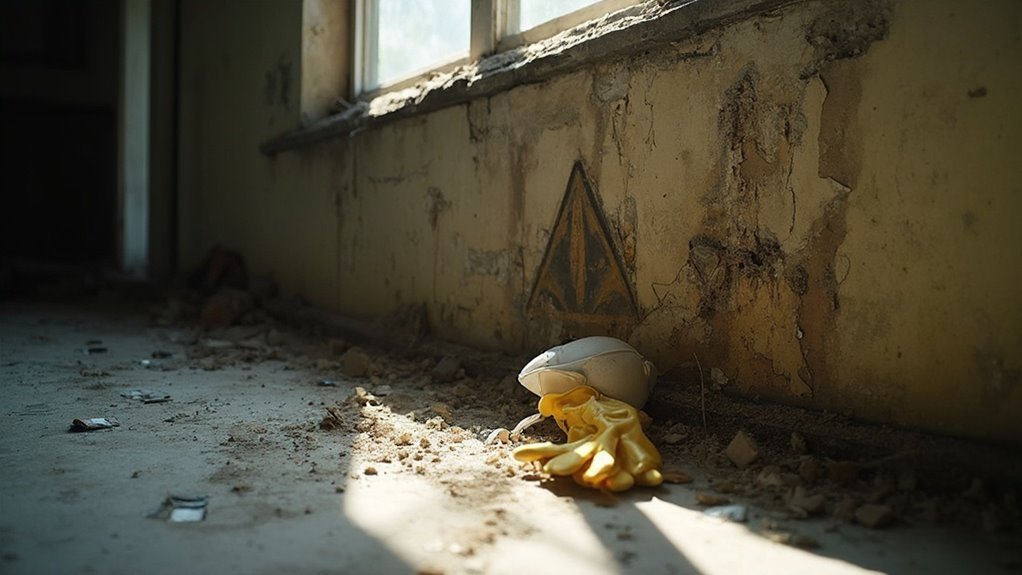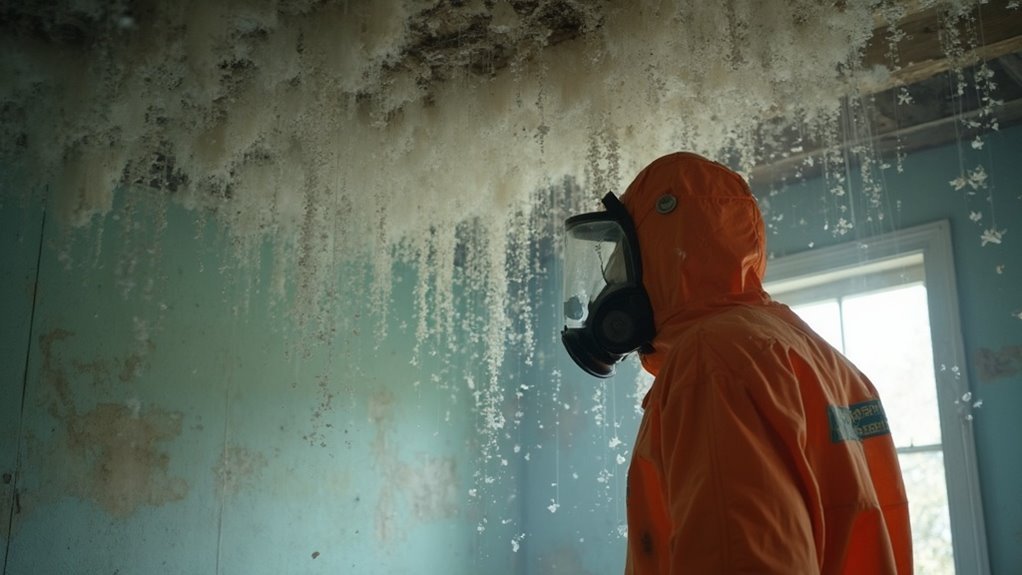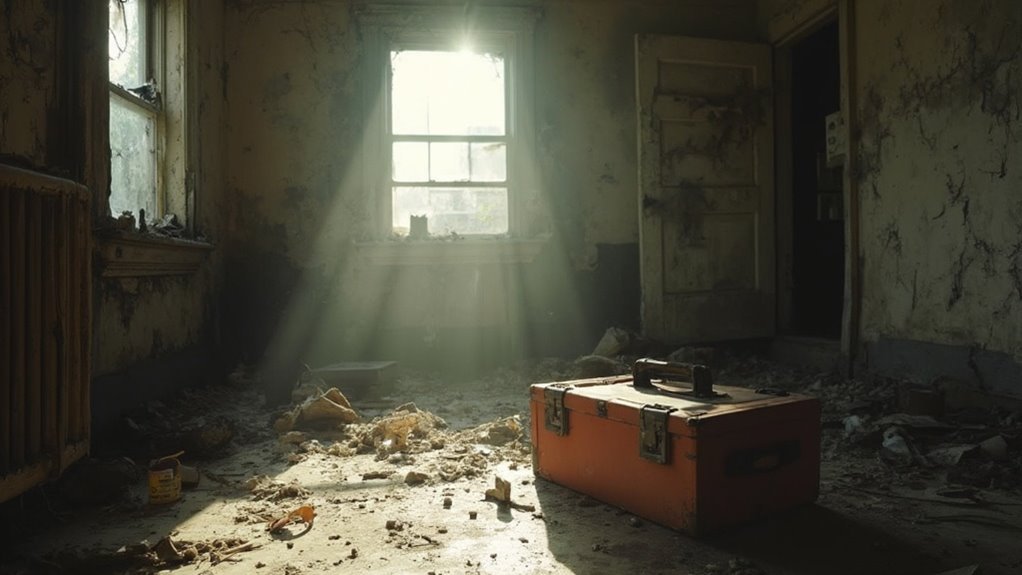If your home was built before the 1980s, it might contain asbestos, a substance linked to serious health risks like lung cancer and mesothelioma. Symptoms can take 20 to 50 years to appear, making early identification vital. Common materials that may harbor asbestos include textured ceilings and vinyl floor tiles. If you suspect its presence, engaging licensed professionals for testing and abatement is fundamental. The abatement process involves encapsulation or removal, alongside strict safety precautions. Understanding these risks and the steps for safe removal can greatly protect your health. There's much more to investigate about ensuring your home's safety.
Understanding Asbestos Risks

Asbestos, a once-popular building material, poses considerable health risks that many people may not fully understand. Exposure to asbestos can lead to serious conditions like lung cancer, mesothelioma, and asbestosis. These diseases often take 20 to 50 years to manifest after initial exposure, emphasizing the significance of health monitoring for those at risk. You might find that the risk increases considerably for smokers, as their chances of developing lung cancer from asbestos exposure are remarkably higher. Approximately 1,300 Americans die annually from asbestos-related conditions, highlighting the importance of awareness.
Asbestos regulations have been established to mitigate these risks, especially in occupational settings. If you work in industries that utilize asbestos, you must adhere to these regulations to prevent exposure. Household exposure can likewise occur, particularly if you live near asbestos mines or come into contact with asbestos workers. Even fibers released into the air from disturbed asbestos-containing materials pose a threat.
Understanding these exposure pathways is critical for your safety. It's vital to stay informed about the potential dangers and engage in regular health monitoring if you think you've been exposed. Taking proactive measures can help protect you and your loved ones from the long-term health consequences of asbestos exposure.
Identifying Asbestos in Your Home
Identifying asbestos in your home can be vital for your health and safety, especially if your property was built before the 1980s. Asbestos fibers can be found in various materials, and recognizing these asbestos material types is important. Common indicators include textured popcorn ceilings, 9-inch vinyl floor tiles from the 1930s to 1970s, and corrugated paper wrap on pipes. You might likewise encounter fibrous cement siding and white or gray papery pipe coverings, all of which may contain asbestos.
When it comes to asbestos detection methods, visual inspection should be your first step. Nevertheless, for accurate identification, professional testing is recommended. Techniques like Phase Contrast Polarized Light Microscopy (PLM) and Scanning Electron Microscopy (SEM) can effectively analyze samples and confirm the presence of asbestos. DIY testing kits may expose you to risks, so it's best to leave this to trained professionals. Engaging qualified inspectors is critical for accurate asbestos identification and ensuring reliable results.
If you suspect asbestos in your home, avoid disturbing the materials and contact a licensed inspector. They can perform a thorough examination and advise you on the safest course of action, ensuring your environment remains safe from asbestos exposure.
The Asbestos Abatement Process

Once you've identified asbestos in your home, the next step is to understand the abatement process. This process is essential to guarantee compliance with asbestos regulations and to protect your health. Here's a breakdown of the key stages involved:
- Preparation and Planning: Develop a thorough abatement plan that includes a risk assessment, permitting, and worker safety protocols.
- Abatement Techniques: Depending on the situation, you may choose methods like encapsulation, removal, or enclosure to manage asbestos safely.
- Execution and Cleanup: Set up containment measures, handle materials carefully, and conduct air quality testing to verify the work area is safe post-abatement.
Throughout the abatement process, it's crucial to follow established asbestos regulations to avoid legal issues and health risks. Each stage requires careful attention to detail, from planning and executing the abatement techniques to guaranteeing proper disposal of hazardous materials. By understanding the abatement process, you can effectively mitigate the dangers of asbestos and maintain a safe home environment.
Safety Precautions During Abatement
During asbestos abatement, it's crucial to consistently implement safety precautions to protect both workers and occupants. These measures not only minimize the risk of asbestos exposure but likewise guarantee safe disposal of hazardous materials.
| Safety Measure | Description |
|---|---|
| Personal Protective Equipment | Always wear NIOSH-approved respirators and appropriate protective clothing. |
| Wet Materials | Wet asbestos-containing materials before work to prevent fiber release. |
| Use Non-Powered Tools | Employ non-powered hand tools to generate less dust and debris. |
| Heavy-Duty Plastic Sheeting | Cover the ground and vegetation with sheeting to catch dust and debris. |
During the abatement process, avoid using high-pressure water jets, as they can spread fibers. Minimize cutting or breaking of materials, and guarantee thorough cleanup using wet methods or HEPA vacuums—never standard vacuums.
Post-abatement, double bag all waste for safe disposal, clean or discard protective clothing, and shower immediately to remove any residual dust. By adhering to these precautions, you greatly reduce the risk associated with asbestos exposure in your home.
Choosing the Right Contractor

When it comes to choosing the right contractor for asbestos abatement, you need to prioritize qualifications and experience to guarantee a safe and effective removal process. Confirming the contractor meets specific criteria can greatly impact your project's success. Here's a quick checklist to guide you:
- Verify State Licenses: Make sure the contractor holds a state-issued license for both residential and commercial asbestos abatement. This is crucial for legality and safety.
- Assess Experience: Interview potential contractors to evaluate their past projects and expertise. Look for those with a strong track record in asbestos removal.
- Check Insurance and Certifications: Confirm that the contractor provides proof of workers' compensation insurance and has certified supervisors. This protects you from liability and guarantees compliance with regulations.
Frequently Asked Questions
How Can I Test for Asbestos in My Home?
To test for asbestos in your home, conduct a thorough home inspection and collect samples. Use professional asbestos testing services for accurate analysis, ensuring you follow safety guidelines and regulations to minimize health risks effectively.
What Symptoms Indicate Asbestos Exposure?
If you're experiencing persistent cough, shortness of breath, or chest pain, these asbestos symptoms could signal exposure signs. Early detection is essential, so don't ignore them—seek medical advice immediately for the best outcome.
Can I Remove Asbestos Myself?
You shouldn't attempt DIY asbestos removal because of significant asbestos health risks. Even small quantities can be dangerous. It's safer to hire certified professionals who understand proper handling and disposal, ensuring your safety and compliance with regulations.
What Are the Costs Associated With Asbestos Abatement?
Think of asbestos abatement like repairing a leaky roof; you've got to evaluate all costs. Abatement costs often range from $1,192 to $3,255, with removal expenses influenced by area, type, and amount of asbestos present.
How Long Does the Abatement Process Typically Take?
The abatement timeline varies based on project duration and complexity. Small projects may take a few days, while larger removals can extend to weeks or months, depending on accessibility and asbestos condition.
